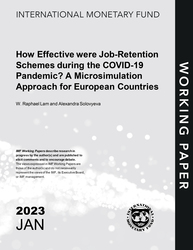
How Effective were Job-Retention Schemes during the COVID-19 Pandemic? A Microsimulation Approach for European Countries
How Effective were Job-Retention Schemes during the COVID-19 Pandemic? A Microsimulation Approach for European Countries
READ MORE...
Volume/Issue:
Volume 2023
Issue 003
Publication date: January 2023
ISBN: 9798400229985
$20.00
Add to Cart by clicking price of the language and format you'd like to purchase
Available Languages and Formats
| English |
Prices in red indicate formats that are not yet available but are forthcoming.
Topics covered in this book
This title contains information about the following subjects.
Click on a subject if you would like to see other titles with the same subjects.
Labor , Economics- Macroeconomics , Economics / General , Job-retention schemes , COVID-19 pandemic , short-time work , inequality , income stabilization , Okun’s Law , job-retention scheme , stabilization in EU , EU household , stabilization coefficient , Income , COVID-19 , Labor markets , Income shocks , Unemployment , Global , Europe
Also of interest
Summary
The COVID-19 pandemic had posed a dramatic impact on labor markets across Europe. Forceful fiscal responses have prevented an otherwise sharper contraction. Many countries introduced or expanded job-retention schemes to preserve jobs and support households. This paper uses a microsimulation approach (EUROMOD) and household data to assess the effectiveness of those schemes in stabilizing household income during the pandemic across European countries. Empirical evidence shows that job-retention schemes were effective in stabilizing income and, along with other measures, absorbed nearly 80 percent of market income shocks—almost doubling the extent of the automatic stabilization of the pre-pandemic tax and benefit systems. The large effects are related to the widespread use and scaling up of those schemes and a deep but short-lived disruption to labor markets during the pandemic. Along with other fiscal support measures, job-retention schemes helped mitigate the rise in the unemployment rate, by about 3 percentage points, and income inequality during the pandemic. Our results show that job-retention schemes were largely targeted, in which households more vulnerable to income losses, such as lower-income families, youth, and low-skilled workers, are able to stabilize their income.
Copyright © 2010 - 2026
Powered by:
AIDC



